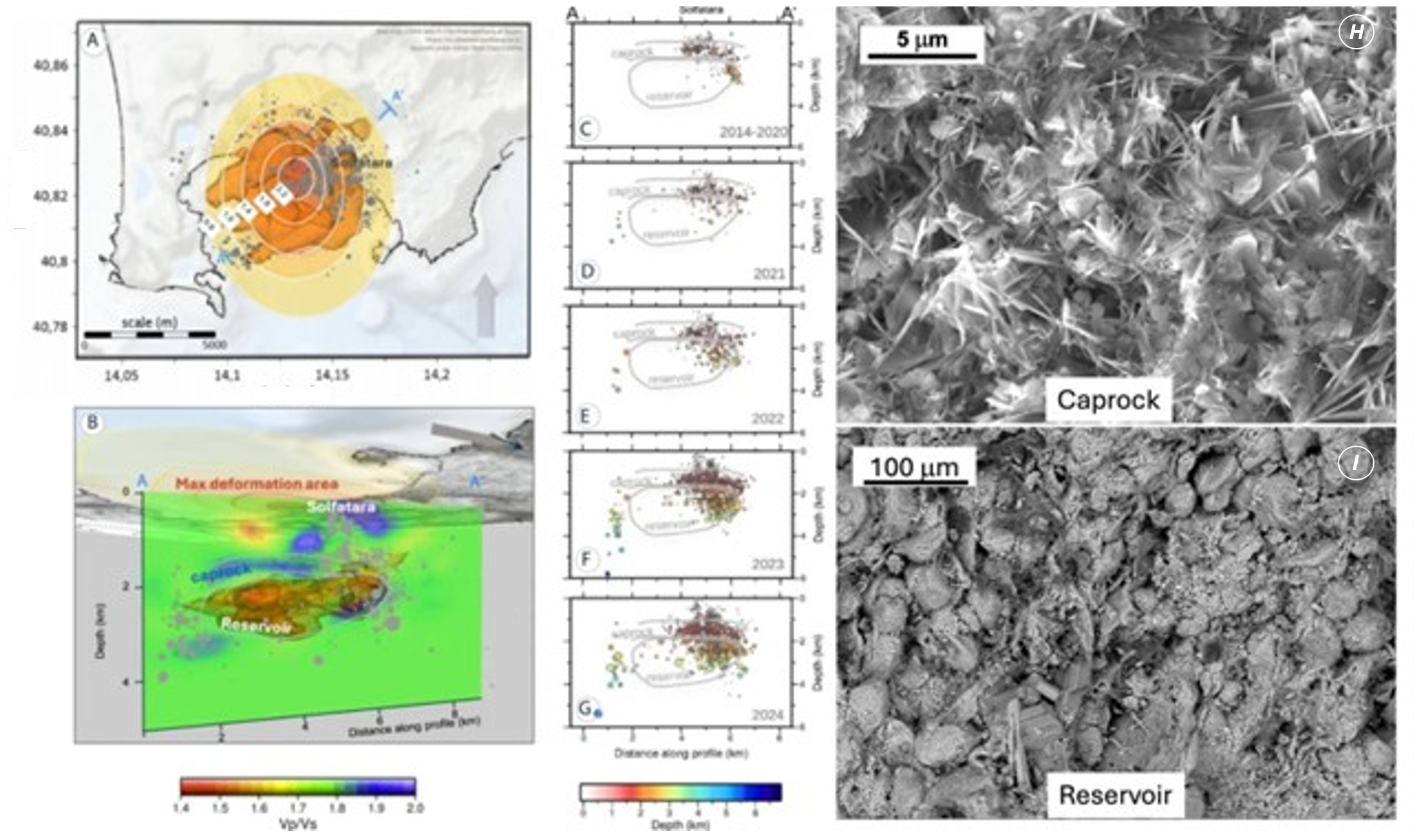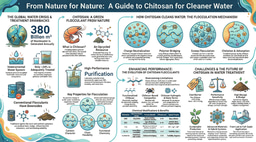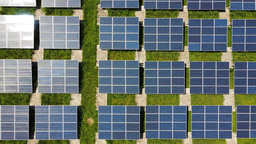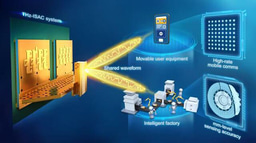Peering into the Depths of Campi Flegrei: How Underground Structures Influence Multi-Hazard Assessment
Published in Earth & Environment

Over the past 75years, the Campi Flegrei caldera, near Naples, has been slowly awakening. This sprawling volcanic system has experienced significant ground uplift episodes, each accompanied by increasingly frequent and powerful earthquakes. The most recent unrest, which began in 2005, continues today, with ground elevation rates reaching up to 3 cm per month. This ongoing deformation, driven by deep underground processes, has raised concerns among local communities and authorities, prompting scientists to dig deeper into the caldera’s subsurface for clues.
Campi Flegrei is a highly complex volcanic system, where ground instability, earthquakes, and eruptions interact in unpredictable ways. Historical records, like those from the 1538 Monte Nuovo eruption, indicate that rapid ground uplift often precedes volcanic activity, but such episodes can also subside without leading to an eruption. Despite decades of research, the caldera’s internal structure remains a geological puzzle, with conflicting models suggesting various possible sources for its ongoing unrest.
Our recent study published in Nature Communications (3D structure and dynamics of Campi Flegrei enhance multi-hazard assessment | Nature Communications) has shed new light on this mystery. By leveraging the intense seismicity of the current crisis, we combined high-resolution seismic imaging and rock physics experiments on core samples from deep wells to reconstruct a more detailed picture of the caldera’s internal structure. This multidisciplinary approach provides detailed confirmation of three key structures, which work in tandem in controlling the distribution of microseismicity and ground deformation.
Just beneath the surface lies a tough, fibrous caprock layer stretching from about 1 to 2 kilometers deep. Spatial and temporal correlations in the evolution of seismicity reveal that this structural element of the caldera is the first to fail (Figure 1, Panels A-G), producing small-magnitude, shallow earthquakes. This arch-shaped horizon, formed from naturally cemented volcanic products, functions as a pressure lid, trapping H2O and CO2 below. Previous and parallel laboratory experiments on site-relevant core samples reveal that this caprock is reinforced by microscopic mineral fibers (Fig. 1, panel I), similar to those used in advanced engineering materials, which enhance its toughness and flexibility. Notably, beneath the Solfatara crater at shallower depth, rocks become saturated with water-steam and CO2, reflecting the upward movement of hot fluids – a key component in the caldera’s long-term behavior.
Beneath this protective shell lies a gas-enriched reservoir, extending from about 2 to 4 kilometers depth (Fig.1 panel H). This layer, filled with water, steam and supercritical carbon dioxide, functions as the “lungs” of the caldera, slowly building pressure over time as fluids accumulate. Laboratory studies on site-relevant rock samples from this depth demonstrate that the volume of this reservoir rock strains exponentially as fluid pressure increases, creating conditions that can drive both ground uplift and seismicity. As pressure rises, reservoir strain transfers to the overlying caprock, triggering earthquakes. The largest recent seismic events, with magnitudes above 3.5, have occurred near the edges of this reservoir, where old fault lines are prone to slipping as the lateral load from reservoir depletion decreases.
Deeper still lies the caldera’s solid basement, a dense, carbonate-rich formation that dips toward the center of the volcanic system. Unlike the fluid-rich layers above, this basement rock is more stable, reflecting the intense heat and pressure it has endured over millions of years. It acts as the structural backbone of the caldera, supporting the overlying reservoirs while slowly releasing carbon dioxide through high-temperature chemical reactions and diffusion from the deeper magma.
Together, these three layers form a complex, interconnected system that drives the caldera’s seismic and ground deformation activity. Critically, the absence of shallow magma within the first 4.5 kilometers suggests that current unrest is primarily driven by pressurized fluids, not imminent magma ascent.
From a multi-hazard perspective, the critical role of fluid-driven processes highlights the need to incorporate geochemical data, rock physics-based seismic signatures, and ground deformation measurements into comprehensive multi-hazard assessments. In this context, during inter-eruptive phases, damage from earthquakes, ground deformation and phreatic explosions represents a major risk to the densely populated areas and infrastructure surrounding the caldera.
This insight is crucial for refining volcanic hazard models and improving warning systems, potentially reducing the risk to the hundreds of thousands of people living nearby.
As scientists continue to map the subsurface of Campi Flegrei, each new discovery brings us closer to understanding the hidden forces shaping this ancient caldera – and what it might mean for the future of one of Europe’s most densely populated volcanic regions.
Credits
The original work has received financial support by:
- THRAM Prin 2022,
- the “Multi-Risk sciEnce for resilienT commUnities undeR a changiNg climate” (RETURN) project, funded by the European Union’s NextGenerationEU and the Italian Ministry of University and Research (MUR) under the PNRR.
- EU through the project GOBEYOND (GA 101121135 - HORIZON-CL3-2022-DRS-01).
- NSF EAR Award (#2149529) to PI T.V at Stanford University.

A Top view of the caldera showing ground uplift isolines and the Vp/Vs anomaly (in orange), interpreted as a gas reservoir. The arrows indicate the north direction. The variation in color intensity and the thickness of the lines represent the magnitude of ground uplift (in cm) recorded between January 2023 and June 2024.
B Schematic cross-section along the AA’ profile, crossing the low Vp/Vs anomaly (gas reservoir). The reservoir is overlain by a layer of more resistant rocks (caprock), identified by a high Vp/Vs anomaly. Beneath the Solfatara crater, an elastic discontinuity zone (in yellow-green) is present, where fluids may escape.
C–G Spatiotemporal evolution of seismicity from 2014 to 2024. Seismic events are color-coded by depth, and the size of the circles indicates magnitude. Early, lower-magnitude earthquakes are concentrated in the caprock layer, while later, larger-magnitude events are distributed along faults bordering the caldera.
H-I Scanning electron microscope images of a reservoir rock sample from deep core drilling (San Vito 1 Well) (H) and a sample of fibrous caprock synthesized by hydrothermal processes (I).
Follow the Topic
-
Nature Communications

An open access, multidisciplinary journal dedicated to publishing high-quality research in all areas of the biological, health, physical, chemical and Earth sciences.
Related Collections
With Collections, you can get published faster and increase your visibility.
Women's Health
Publishing Model: Hybrid
Deadline: Ongoing
Advances in neurodegenerative diseases
Publishing Model: Hybrid
Deadline: Dec 24, 2025




Please sign in or register for FREE
If you are a registered user on Research Communities by Springer Nature, please sign in